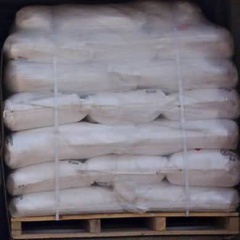Sodium metasilicate
| Infobox on Sodium metasilicate | |
|---|---|
| Example of Sodium metasilicate |  |
| Facts | |
| Origin | - |
| Stowage factor (in m3/t) | - |
| Humidity / moisture | - |
| Ventilation | - |
| Risk factors | See text |
Sodium metasilicate
Contents
Description
Sodium silicate is the common name for a compound sodium metasilicate, Na2SiO3, also known as waterglass or liquid glass. It is available in aqueous solution and in solid form and is used in cements, passive fire protection, refractories, textile and lumber processing, and automobiles. Sodium carbonate and silicon dioxide react when molten to form sodium silicate and carbon dioxide.
In industry, the various grades of sodium silicate are characterized by their SiO2:Na2O ratio, which can vary between 2:1 and 3.75:1. Grades with this ratio below 2.85:1 are termed 'alkaline'. Those with a higher SiO2:Na2O ratio are described as 'neutral'.
Sodium silicate is a white powder that is readily soluble in water, producing an alkaline solution. It is one of a number of related compounds which include sodium orthosilicate, Na4SiO4, sodium pyrosilicate, Na6Si2O7, and others. All are glassy, colourless and soluble in water.
Sodium silicate is stable in neutral and alkaline solutions. In acidic solutions, the silicate ion reacts with hydrogen ions to form silicic acid, which when heated and roasted forms silica gel, a hard, glassy substance.
Application
Sodium metasilicate is widely used for the manufacture of a variety of detergents, used as rust remover for metal, grinding aids for ceramics, deinking agent for paper, dyeing and printing auxiliary for removing oil in textile industry, and also used as the raw material for flameproofing agent, plastic maintenance agent, water retention agent, etc.
Shipment / Storage
Consult the IMDG Code (International Maritime Dangerous Goods Code) for overseas transport. Also see the applicable MSDS sheet for safe handling advice.
Risk factors
Dangerous reaction with oxidizers. In the presence of moisture, reacts with aluminium, zinc, tin and their compounds, evolving hydrogen, a flammable gas. Causes burns to skin, eyes and mucoius membranes. Reacts violently with acids.











